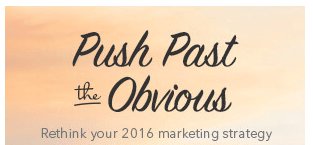How to Create a Marketing Strategy 10X Better Than Your Competitors
In today’s small business environment, your competitors may be more focused on the shiny objects in their marketing, things like SEO, responsive web design, pay-per-click advertising, and of course whatever the latest fad in social media happens to be in any particular week, rather than creating a strong marketing strategy to ensure the effectiveness of these things.
Of course all of these things are important and have a role to play in successfully marketing your business, but while all of these constantly changing and evolving areas have been dominating the conversation, one time-tested marketing approach has continued to quietly provide good results for those relatively few small business owners who have truly mastered it:
A strong marketing strategy!
Few things are more confusing or mystifying to business owners more than the idea of marketing strategy.
But, rather than debate the proper way to define what marketing strategy is, I would like to share how to develop it, install it and give it a voice. No matter how perfectly you state your marketing strategy, if it doesn’t live firmly in the tactics you employ to develop and keep customers it’s all for nothing.
Here’s how to create a marketing strategy 10X better than your competitors:
1. Find Your Unique Positioning
This is how you state you’re different from your competitors. It’s your unique positioning in the market and it must be developed after you’ve defined your ideal customer. Scheduling some time to ask your best customers why they do business with you, may offer some insight into how you are different in ways that will attract other potential customers.
Positioning or your USP involves planting “seeds of perception” in the minds of prospects and customers, which by-the-way are already crowded.
Some small business examples are:
- The Vegan Chef. Take-out meals for vegans—positioned in the minds of vegans wanting take-out meals.
- 48 Days. Meaningful, purposeful and profitable work in 48 Days—positioned in the minds of job seekers wanting change in 48 Days.
- First Responder Cleaning. There are very few one-of-a-kind cleaning services. They offer a 30 minute response time.
- Punctual Plumber. We’re on time —offers to pay customers $5 for every minute they’re late up to $300.
- Indispensable Marketing. Strategic marketing that is essential for success—positioned as vital and needed marketing help to grow your business.
I’ve written about this idea frequently and suggest you download my free eBook on the topics of ideal customer and on positioning strategy to get very specific how to instructions on this element.
2. Create a Customer Journey Framework
Strategy-first thinking forces you to push your core marketing strategy above into every marketing activity. I’ve developed a very powerful approach for building this kind of customer journey.
Our approach to the customer journey is a concept that asks you to create processes, offerings, and campaigns aimed at strategically moving prospects and customers through five stages – Awareness, Education, Sample, Purchase and Refer. By viewing each of these stages as a place to reinforce your USP as well as deliver key educational information, you create the kind of journey that leads to your profitable customers .
Awareness – This is the phase where sales, social media, content, networking, public relations will do well and even search, advertising and referrals start here.
- Do your online and offline ads communicate the brand positioning? Do they target and offer to begin the relationship process with your ideal customers?
- Do your social media outpost have consistent images and messages?
- Are brand messages promoted on your website?
- Are your networking or partner marketing efforts targeted towards your ideal customer?
- Are your keywords consistent and focused on the phrases that actual prospects search for?
- Do you have a formalize process to handle referrals that come in?
Education – This is the stage where once you attracted prospects to your website or location you have give them reasons to come back, reasons to relate and even reasons to like your team and also provide reviews, success stories and client testimonials.
- Do your online and offline content assets include your message and brand identity?
- Do your business email signatures and cards include your positioning?
- Is your vision and unique differentiation documented on your website for your ideal customers to relate to?
- Is your website showcasing reviews, success stories or testimonials?
- Are your ongoing communication campaigns consistent with your website branding? Do these communication initiatives go out on a regular basis and include valuable content for your audience? Is there an opt-in incentive for your content?
- Are your email campaigns consistent with your branding?
- Do you follow a content creation system to establish your company as an expert on focused topics?
- Do you regularly promote and monitor review sites?
Sample – Now that prospects are wondering how your solution might work for them it’s time to demonstrate to them with reports, ebooks, webinars and very detailed how to information. You might also have an assessment, audit, seminar, evaluation, trial version or low cost offer here.
- What is your offering for prospects to sample your expertise, product or service?
- How do you encourage people to sign up for the offering?
Need some ideas? 7 Ways Prospects Can Sample Your Service or Product
- Demo— a group consulting model that would demonstrate expertise by offering advice and answering questions in a free weekly session that could be upgraded to one-on-one consulting
- 30 – 90 Minute Consultation or Coaching— A personal or life coach might create a “get unstuck” in 3 sessions mini engagement that allows someone to try out coaching without a long term commitment
- Audit— an marketing firm may offer a free or low cost audit providing solid recommendations that could turn into long-term paid projects
- Trial Offer— an home improvement contractor might create a 4-Hour You Point and We Fix starter offering
- Assessment— an structural engineering firm might sell a feasibility analysis as a product.
- Seminar or Workshop— an sales training and development firm might offer free a seminar with worksheets and CDs.
- Basic or Low Cost Version— an accounting firm might sell a certain type of low-cost tax return.
Purchase – For this stage the focus is still on educating but from the standpoint of a new customer
- Do your kits, contracts and invoices match your branding and communicate key information?
- Do your new customer gain access to key personnel or content?
- Do your new customer become part of a exclusive club?
Refer – The customer journey is ultimately about referrals
- How do you encourage or motivate your current customers to refer?
- Does your incentive for referrals connect with your culture in some way?
3. Map Educational Content to Strategy
Once you develop your USP and outline your Customer Journey it’s time to give your strategy voice. This is done by mapping how you will communicate your USP through educational content that creates awareness, educates, builds trust, engages and converts.
Over the years I’ve identified four types of content that every business must create. Organizations that get this and create and organize content to connect at any point along the journey will win.
Suspect Content – Everyone in your target market
When your entire target market is not aware of your company, product, service or the benefit it offers, then the first objective of content is to simply build trust.
Trust can be built through:
- Blogs
- Testimonials
- Customer Reviews
- Articles
At the heart of every transaction is TRUST and in general, trust is what’s in short supply. If more people trust you, everything else will fall into place.
There’s a really big gap between someone being aware of you (which is really hard) and someone trusting you, enough to invest in you or buy from you.
Prospect Content – Anyone who has taken action to solve a problem that you can assist them with
There’s an huge difference between awareness and action. Putting something in the world for awareness is useless if it doesn’t lead to taking action.
As the market begins to trust you and competition increasing in that market. Prospects will compare you on price unless you give them a differentiation….your unique process, your solution, your message and your approach.
Examples of a unique process or approach:
- 5 Components of a Successful _______,
- How to __________ in 5 Steps,
- 10 Steps to ______________ Success,
- 8 Steps to Successfully Implement __________,
At this stage you need to educate about that differentiation:
- Special Reports
- Information Packed Guide
- Marketing Kit
- Seminar
People want to be educated not sold. They will sell themselves if you just commit to educating.
Customer Content – A person or organization that has bought products or services from you
You’ve done all this work attracting and educating now show your customers how to get the most out of what they just bought. This builds loyalty and community.
- How-to Information
- New Customer Guide
- Workshops
- Q&A Sessions
This is were most organizations stop their content marketing but you should continue it if you want keep customers and create repeat sales.
Advocate Content – A person or organization that tells others and basically sells for you
The last stage of content that creates and keeps a customer is one that’s often overlooked. Ultimately, great content has the ability to help your raving fans spread the word, increase awareness, generate leads and convert prospects .
- Referral certificate or coupon
- Access to “behind the scenes” content
- Customer appreciation events
- Referable emails
In other words, in many cases how you sell is more important than what you sell.
You won’t create every tactical initiative involved in executing these five steps, but the planning process involved in fully developing your organization’s marketing strategy must consider these elements as three parts of the strategy puzzle.





